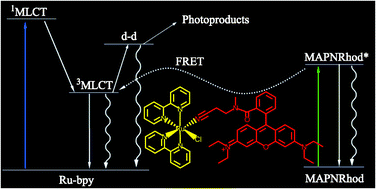
Due to the fundamental photochemistry of the system it has not been possible to obtain a phototrigger presenting both high absorption at longer wavelengths (500nm) and a high photorelease quantum yield. In this study the problem is circumvented by a coordinated fluorescent fragment harvesting long wavelength light and transferring this energy to the ruthenium centre, allowing high photoactivity at long wavelengths with very high absorptivity and high energy transfer quantum yield.
The behaviour of phototriggers, which releace a monodentate ligand through the d-d decomposition path, can be used to design caged compounds. Many molecules, including neurotransmitters and other biomolecules can be photodelivered using these complexes, which makes this one of the most promising techniques to cage drugs for photodynamic therapies, for neuroscience and for photoregulation of biological processes in general. This new mechanism found in a rhodamine-enhanced ruthenium phototrigger opens a full set of possibilities for designing Ru–bpy sensitizers, based in rhodamine and possibly other fluorescent dyes.
Read the full article for free until 10th April by clicking on the title below:
Energy transfer from a rhodamine antenna to a ruthenium–bipyridine center
Oscar Filevich, Beatriz García-Acosta and Roberto Etchenique
Photochem. Photobiol. Sci., 2012, Advance Article, DOI: 10.1039/C2PP05415A










